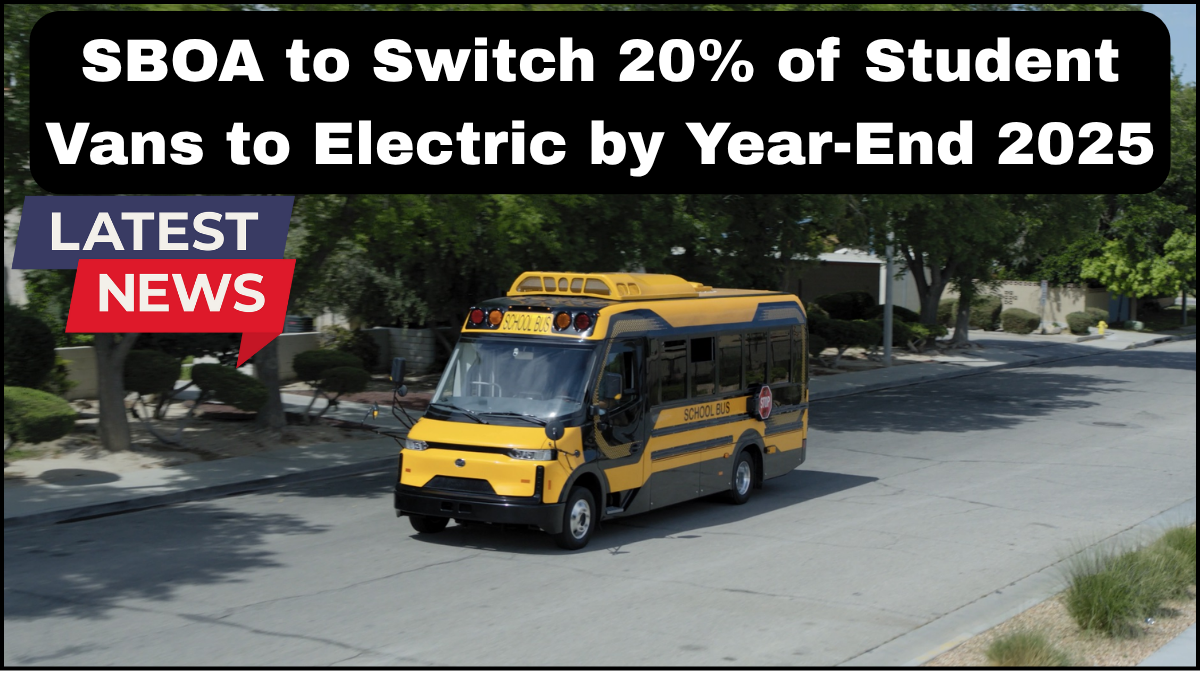The School Bus Operators Association (SBOA) has announced a major initiative aimed at accelerating the transition toward sustainable student transportation. By the end of 2025, SBOA plans to convert 20% of its student van fleet to electric vehicles (EVs), marking a significant step in the nationwide school EV transport switch.

Why SBOA Is Making the Switch
Concerns over environmental impact, rising fuel costs, and regulatory pressures have all contributed to the growing urgency to modernize school transportation systems. SBOA’s shift toward electric vans for students is not just a response to these challenges—it’s a proactive strategy to future-proof student mobility.
This move aligns with global efforts to cut carbon emissions in the transportation sector, particularly in urban areas where traffic congestion and air quality are major public health concerns. School transport plays a significant role in daily commuting patterns, and electrifying even a portion of that fleet can create measurable environmental benefits.
Strategic Goals Behind the 20% Target
The decision to start with 20% of the fleet is both ambitious and strategic. It allows SBOA to:
-
Test operational feasibility across different climates and routes
-
Train drivers and maintenance staff gradually without overwhelming resources
-
Establish charging infrastructure where it’s needed most
-
Evaluate long-term cost savings compared to conventional fuel-powered vans
The initial batch of EVs will be deployed in areas where route lengths and electric charging access make the transition most practical, such as suburban school zones with moderate daily mileage.
Benefits for Students and Communities
Switching to electric vans for students delivers multiple advantages beyond environmental impact:
-
Cleaner air around schools: Traditional vans emit harmful pollutants like nitrogen oxides and particulate matter. Electric vans eliminate tailpipe emissions entirely.
-
Reduced noise pollution: EVs are significantly quieter, improving the acoustic environment near schools and neighborhoods.
-
Improved safety: Many modern electric vans come equipped with enhanced safety features and updated driver assistance systems.
-
Lower operating costs: Fewer moving parts and lower fuel expenses mean reduced maintenance and long-term savings for school districts.
These benefits directly enhance student well-being and support broader community goals related to sustainability and public health.
Funding and Policy Support
Federal and state governments have introduced a range of incentives to encourage EV adoption in school transportation. SBOA is actively leveraging these programs, including grants from the Environmental Protection Agency (EPA) and transportation-specific EV funds under the Infrastructure Investment and Jobs Act (IIJA).
Many state-level policies now mandate emissions reduction targets for public transportation. By committing to the school EV transport switch, SBOA positions itself ahead of these regulations and sets an example for other school transport providers.
Challenges and Implementation Plan
Transitioning a portion of the fleet is not without its hurdles. Key challenges include:
-
Initial investment costs for electric vans and charging infrastructure
-
Driver and technician training
-
Route planning adjustments to match battery capacities
-
Reliable vehicle supply from manufacturers
To address these, SBOA is partnering with vehicle manufacturers, EV infrastructure firms, and local governments to roll out the transition in phases. The 2025 target is supported by a detailed roadmap that includes:
-
Pilot projects in 10 school districts
-
Infrastructure audits at key transportation hubs
-
A full performance and cost review at the 12-month mark
A Signal of Broader Change
SBOA’s move is more than a fleet upgrade—it’s part of a systemic shift in how school transportation is conceived and delivered. As students and parents become more environmentally conscious, demand for clean transport options is expected to rise. The electric transition also opens doors to smart fleet management, real-time tracking, and improved service reliability.
This initial 20% shift could serve as a catalyst for a wider transformation, potentially influencing policies, supplier priorities, and public expectations around how students are transported to and from school.
Frequently Asked Questions (FAQ)
Q1: Why is SBOA only switching 20% of the fleet for now?
A phased approach allows SBOA to manage risks, evaluate technology performance, and ensure operational readiness before scaling up further.
Q2: What types of electric vans will be used?
SBOA is currently evaluating models from major EV manufacturers such as Ford, Rivian, and Lion Electric, focusing on safety, range, and total cost of ownership.
Q3: Will electric vans impact student pick-up and drop-off times?
No significant delays are expected. Most school routes fall well within the battery range of modern electric vans.
Q4: How is this transition being funded?
SBOA is utilizing a mix of federal grants, state incentives, and private partnerships to fund the transition.
Q5: Are other school districts expected to follow suit?
Yes. SBOA’s early commitment is likely to influence other districts to adopt similar strategies as infrastructure and EV supply chains mature.
click here to learn more